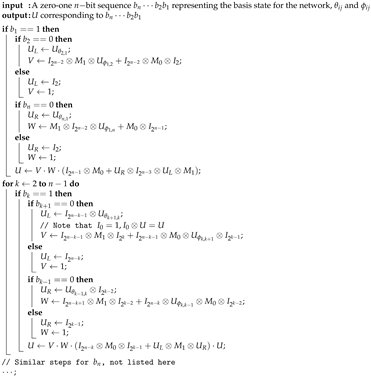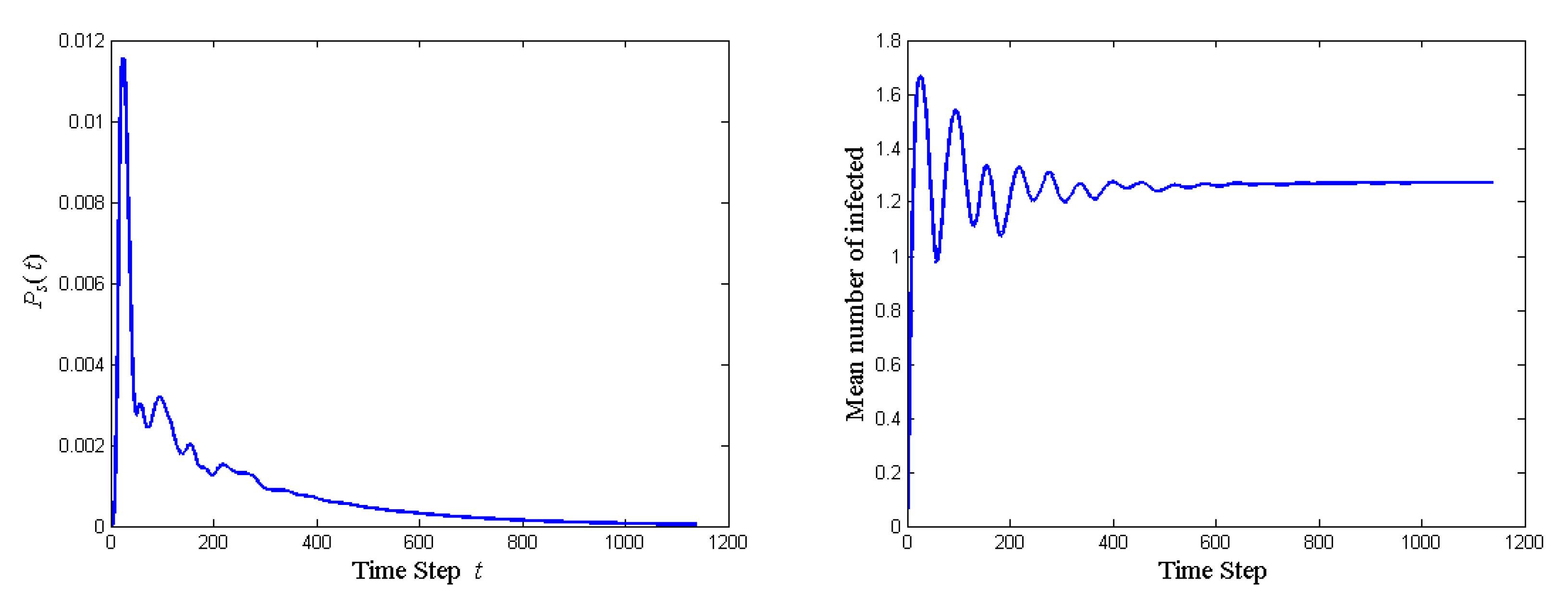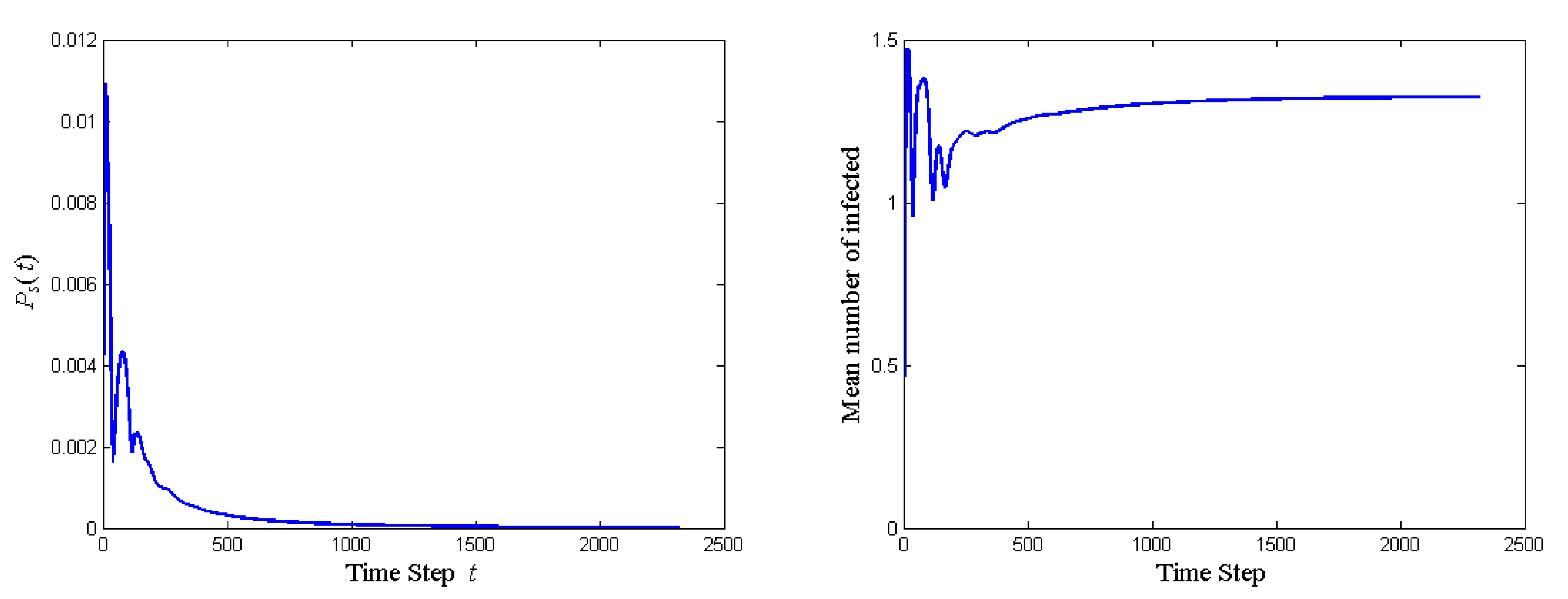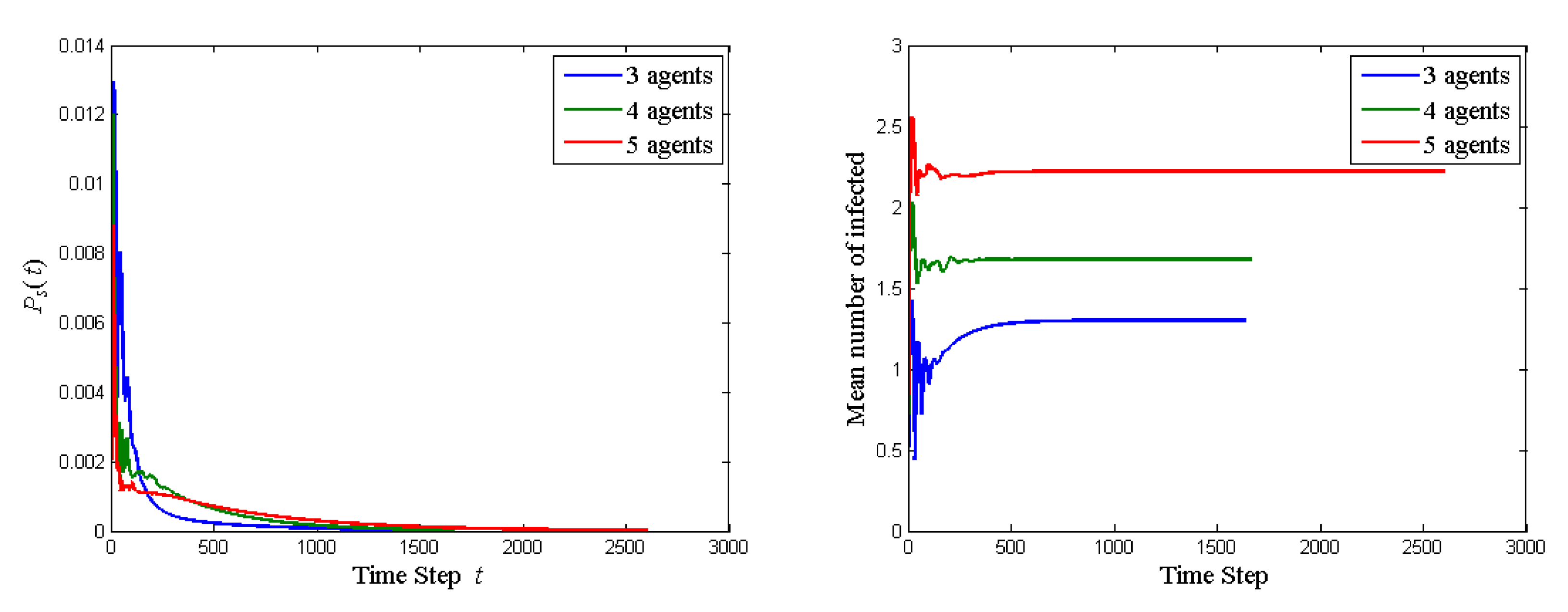4.1. No Disinfection
Let and for . Then is more easily infected than and since is the starting point of the propagation. Let and for . Then, and for , and for , and for , and for , and for . With these settings, the first one to talk, whether she tries to infect or disinfect, has more influence than the second one to talk. Thus the influence of the sender has on the receiver is always more powerful than the counteraction of the receiver has on the sender. Note that the sender may send infection or disinfection.
We take
in the stopping rule. The probability of stopping the quantum walk, that is, to reach the all-infected state,
, and the mean number of agents affected, at each time step until the quantum walk stops is shown in
Figure 1. The time evolution curves have many sharp oscillations, indicating many back-and-forth arguments in the network. It takes 1139 steps to stop the quantum walk.
is very low, smaller than 0.012, in each step.
rises rapidly to the peak value at the 24th step, and then drops rapidly. After 400 steps,
just decreases slowly. The propagation of idea is fast only at the very beginning and is slow afterwards. Note that
represents the state of the social network and its diagonal elements are the probabilities of getting the basis state. Thus the
entry of
is the probability that the network is in non-infected state (
) at step
t,
entry is the probability of only
is infected (
), and so forth. The mean number of agents affected at step
t is
where
is the column vector formed by diagonal entries of
. The mean number oscillates much in the first 200 steps and goes to a steady value of 1.27 after 600 steps.
Table 1 lists the probabilities of each state at the last step. The distribution is quite uniform. Note that the probability of all infected (000) is 0 since
is obtained by projection removing 000 in Equation (
49).
4.2. Stubborn Conservative Guy in the Middle
Consider the following case: is conservative and stubborn while and are open-minded and compliant. Thus it is easier for to persuade than it is for to persuade .
Set and for .
Set and for . Thus it is easier for to disinfect than it is for to infect .
Set and for . If is infected, he can infect his two neighbors powerfully. If and are not infected at all, they can slightly disinfect .
Set and for . If is infected, he can infect powerfully. If is not infected at all, she can slightly disinfect .
Set and for . If is infected, she can infect slightly. If is not infected at all, he can disinfect powerfully.
Set and for . If is not infected at all, he can disinfect his two neighbors powerfully. If and are infected, they can slightly infect .
Set and for . Thus it is easier for to infect than it is for to disinfect .
The probability of stopping the quantum walk and the mean number of agents affected at each step of the stubborn-middle network is shown in
Figure 2. Note that the horizontal axis is in log scale since it takes much longer to stop the quantum walk than in the last subsection (5762 vs. 1139).
with a stubborn guy in the middle (
Figure 2) is much lower than that without a stubborn guy in the middle (
Figure 1), since the infection rate is much slower (smaller rotation angle). The mean number of infected in
Figure 2 is also smaller than that in
Figure 1 in initial stages, but it catches up in later stages. This indicates that the stubborn guy in the middle acts as a barrier to idea propagation only at the initial stages but accelerate the propagation after he is persuaded, since the middle guy is hard to be persuaded by neighbors (small controlled rotation by neighbors) and is influential over neighbors (large controlled rotation by the middle guy).
The results demonstrate that the proposed model is able to model asymmetric interactions between agents with a stubborn guy in the middle. Next we will further demonstrate this by applying the proposed quantum walk to asymmetric interactions between agents with a compliant guy in the middle.
4.3. Compliant Open-Minded Guy in the Middle
Consider the following case: in this subsection is more compliant and open-minded than in the last subsection.
Set for . Here the three agents are equally open-minded.
Set and for . Thus it is easier for to infect than it is for to disinfect .
Set and for . If is infected, he can infect his two neighbors powerfully. If and are not infected at all, they can slightly disinfect .
Set and for . If is infected, he can infect powerfully. If is not infected at all, she can slightly disinfect .
Set and for . If is infected, she can infect slightly. If is not infected at all, he can disinfect powerfully.
Set and for . If is not infected at all, he can slightly disinfect his two neighbors. If and are infected, they can infect powerfully.
Set and for . Thus it is easier for to infect than it is for to disinfect .
The probability of stopping the quantum walk and the mean number of agents affected at each step of the compliant-middle network is shown in
Figure 3.
with a compliant guy in the middle (
Figure 3) is slightly lower than that in the no-disinfection case (
Figure 1), but it takes much longer to stop the quantum walk, since the infection rate is much lower. The lower infection rate is not exactly due to smaller rotation angles. Instead, it is due to disinfection (negative rotation angle) compared to the no-disinfection case. The mean number of infected in
Figure 3 is less oscillatory and smaller than that in
Figure 1 in initial stages, but it catches up in later stages. This indicates that the compliant guy in the middle facilitates idea propagation throughout the quantum walk. The smooth propagation brought by the middle guy can be explained as follows. Although the compliant guy is not very influential over neighbors (large controlled rotation by the middle guy) and thus does not accelerate the propagation after he is persuaded, but the middle guy is easily persuaded by neighbors (small controlled rotation by neighbors).
The results in the previous three subsections demonstrate that the proposed model is able to model asymmetric interactions between agents with various personalities communicating in a line graph structure. Next we will further demonstrate this by applying the proposed quantum walk to asymmetric interactions between agents communicating in a ring graph structure
4.4. Ring Graph
Set all
and all
. The probability of stopping the quantum walk and the mean number of agents affected at each step of the quantum walk on the ring graph are shown in
Figure 4. As the size of the network increases,
drops more rapidly in the first few steps but drops more slowly in later steps, and it takes longer for the new idea to prevail the whole network. This can be explained by the fact that each agent is initially exposed to the new idea (see Equation (
72)) and thus larger networks have more agents initializing the propagation, but it still takes longer time for more agents to end at the same basis state. The mean numbers of infected evolving with time with different network size has the same pattern: oscillating in the first few steps and then converge in later steps. The oscillation in the larger network is less intensive since larger population provides larger buffer and thus there is less back-and-forth changes of minds. With one agent added, the increase in the mean number of infected from 3 to 4 is larger than that from 4 to 5. This can also be explained by the fact that adding an agent is adding an idea initiator and messenger.
Up to this point, we apply the proposed quantum walk model to idea propagation in a social network of agents with various personalities. In such a setting, all agents have the same initial state (not knowing the new idea) and the same final state (accepting the new idea). Next we apply the proposed quantum walk model to group decision making in the next subsection.
4.5. Reaching Agreement
In group decision making, the group members have different ideas initially. After the group discussion, an agreement is reached. Consider a binary group decision making problem where each group member’s local state is either 1 or 0, for example, agreeing on passing the proposal or disagreeing. Suppose the decision can be made only if the group has reached an agreement, that is, all members are 1 or all members are 0. The special case of all members having the same initial state is trivial since no discussion is needed and the decision can be made immediately. The goal of this subsection is to investigate the influence the initial distribution of tendencies of the group members on the final decision.
The initial state of the network is no longer
. Actually the initial state is the influencing factor that we want to investigate. Take a 3-member group as example. If
and
is completely sure of option 1 while
is completely sure of option 0, then the initial state is
. This is a special case of all agents being completely sure of one option. Actually an agent may not be completely sure. In this case, the initial local state of the agent is a superposition state over
and
. Then the initial state of the
n-agent network is the tensor product of the initial local states of the agents:
where
is the local state of
. Again we lift the network by tensor product with its mirror so that one works as controller and the other works as target. The initial control state and the initial target state are the same. The initial state of the quantum walk is still given by
and
.
We are also interested in how long it takes for a group to reach agreement. Note that now we have two stopping states, namely,
and
. All the group members take the same option. When either state is reached, the quantum walk is stopped; Otherwise the quantum walk continues. The measurement operator to get the stopping state is thus
Correspondingly, the measurement operator to get the states to continue, is
for an
n-member group.
The first step of the quantum walk is still given by Equations (
40)–(
44) and the iteration is still given by Equations (
45)–(
51). These equations are valid for
n-agent networks.
In the new idea propagation setting, controlled by just infects each agent by a small amount. Let n be the number of agents In the group decision making setting, we set since the group members have initial opinions related to the decision and there is no need to initialize.
In group decision making, besides the time to stop the quantum walk (resp. to make the decision), we are also interested in the final state (resp. which decision is to be made). Suppose the quantum walk stops at step
. Let
and
be as given by Equations (
46) and (
47), respectively. Then the final state is
The probability to reach an agreement of taking option
i (
) is
where
is
matrix with all entries zero except (1, 1) entry being 1 and
is
matrix with all entries zero except (
,
) entry being 1.
Consider a 5-member group with connections in a ring shape. The initial state configurations in the group are shown in
Figure 5 where the solid circle represents a member initially completely sure of taking option 1 and the hollow circle represents a member initially completely sure of taking option 0. Besides these four initial configurations, we consider one more configuration, called Initial 5. In
Figure 5a, let the solid circle and the hollow circle represent the state
and the state
, respectively. Thus three members are 80% sure of taking option 1 while two agents are 10% sure of taking option 1.
Set al.l
and all
. Thus, all members are equally powerful in persuading the neighbors and equally likely to be persuaded by neighbors. The probability of stopping the quantum walk and the mean number of agents affected at each step of the quantum walk on the 5-member ring graph with various initial state configurations are shown in
Figure 6. The quantum walk has certain ergodicity properties:
and mean number of infected member (taking option 1) are different in the first tens of steps but they coincide after 100 steps. The final state is superpositioned over
and
. The probability to take option 1 (measurement result being
) is 0.7488, the same for all these initial configurations. This can be explained by the mechanism of Algorithm 1: In each time step, the interaction occurs in order clockwise (See
Figure 5) between two agents. The interactions do not occur simultaneously. What’s more, the interaction always starts from the top solid node in
Figure 5 influencing the hollow node on the right side. The agent who first talks has advantage over those who talk later. Therefore, the advantage of talking first and the discussion procedure dominate the effect of initial opinions.
4.6. Interference Effects
One important reason for exploring quantum networks is that they can produce interference effects when comparing a system that is disturbed by measurements to a system that is not. To see the interference effect in the quantum walk on social network, again take the 5-member group decision making ring network as example. Note that although Equation (
42) and Equation (
49) perform measurements, they do not produce interference effects on the intermediate states since they do not affect a particular intermediate state. We can let the quantum walk evolve until the stopping criterion is reached. We can also measure the quantum walk in the half-way before the stopping criterion is reached and then let the quantum walk evolve again for the next half. Such an intermediate measurement is of practical significance. In the middle of the group discussion, each member may be asked to vote. This voting is not used for group decision making, but rather used as an indication of agreement. Note that we can measure at any intermediate step to see the interference effect. Measure at exactly half-way is just one of the many options.
Consider the configuration of Initial 5 in the last subsection. Without half-way measurement, we let the quantum walk evolve for 50 steps. To see the interference effect, we measure the quantum walk half-way. At the 25th step, we only measure
and
. Then the local states of
and
collapse to basis states (
,
,
,
) while the other agents’ states are still superpositioned. We can measure them with four measurement operators:
, where
is a
matrix with all entries zero except the
ith diagonal entry being 1 for
. The probability to get
is
. Then we let the quantum walk evolve for the remaining 25 steps. The probability of stopping the quantum walk and the mean number of agents affected at each step of the quantum walk on the 5-member ring graph with various results of half-way measurement on
and
are shown in
Figure 7. With half-way measurement, the measured agents are forced to make a decision and a new path of quantum walk is produced. Four possible new paths of quantum walk can be produced for four possible results of measurement. The partially collapsed new paths deviate from the original fully superpositioned path. Due to the ergodicity of the proposed quantum walk, all paths will eventually converge to the same path. If the group discussion can go on without time constraint, then interference effects would not affect the final decision. However, with constraint on discussion time, interference effect cannot be ignored. At the 25th step, the probabilities of
and
choosing 00, 01, 10, 11 are the 1st, 2nd, 3rd, 4th entry of
, respectively. At the 50th step, the probability of all members choosing option 1 for the four new quantum walks are 1st, 2nd, 3rd, 4th entry of
, respectively. According to classical probability, the probability for the group to choose option 1 at the 50th step is
. However, the probability for the group to choose option 1 without half-way measurement at the 50th step is 0.7602. This violation of the classical Bayes rule is the so-called quantum interference effect. The reason for the interference effect is that the quantum state evolution is based on amplitude instead of amplitude magnitude squared (probability).















